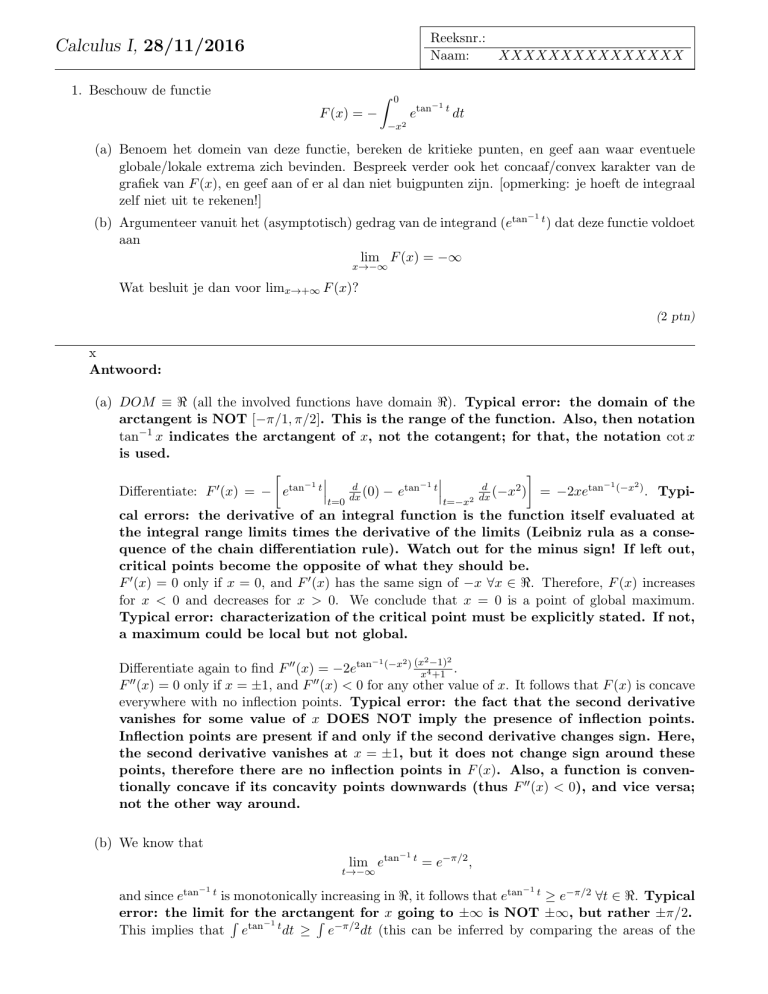
Reeksnr.:
Naam:
XXXXXXXXXXXXXXX
Calculus I, 28/11/2016
1. Beschouw de functie
Z
0
−1
etan
F (x) = −
t
dt
−x2
(a) Benoem het domein van deze functie, bereken de kritieke punten, en geef aan waar eventuele
globale/lokale extrema zich bevinden. Bespreek verder ook het concaaf/convex karakter van de
grafiek van F (x), en geef aan of er al dan niet buigpunten zijn. [opmerking: je hoeft de integraal
zelf niet uit te rekenen!]
−1
(b) Argumenteer vanuit het (asymptotisch) gedrag van de integrand (etan
aan
lim F (x) = −∞
t)
dat deze functie voldoet
x→−∞
Wat besluit je dan voor limx→+∞ F (x)?
(2 ptn)
x
Antwoord:
(a) DOM ≡ < (all the involved functions have domain <). Typical error: the domain of the
arctangent is NOT [−π/1, π/2]. This is the range of the function. Also, then notation
tan−1 x indicates the arctangent of x, not the cotangent; for that, the notation cot x
is used.
−1 t −1 t −1
2
d
d
0
tan
tan
2
Differentiate: F (x) = − e
(−x ) = −2xetan (−x ) . Typi
dx (0) − e
2 dx
t=0
t=−x
cal errors: the derivative of an integral function is the function itself evaluated at
the integral range limits times the derivative of the limits (Leibniz rula as a consequence of the chain differentiation rule). Watch out for the minus sign! If left out,
critical points become the opposite of what they should be.
F 0 (x) = 0 only if x = 0, and F 0 (x) has the same sign of −x ∀x ∈ <. Therefore, F (x) increases
for x < 0 and decreases for x > 0. We conclude that x = 0 is a point of global maximum.
Typical error: characterization of the critical point must be explicitly stated. If not,
a maximum could be local but not global.
2
2
Differentiate again to find F 00 (x) = −2etan (−x ) (xx4−1)
.
+1
F 00 (x) = 0 only if x = ±1, and F 00 (x) < 0 for any other value of x. It follows that F (x) is concave
everywhere with no inflection points. Typical error: the fact that the second derivative
vanishes for some value of x DOES NOT imply the presence of inflection points.
Inflection points are present if and only if the second derivative changes sign. Here,
the second derivative vanishes at x = ±1, but it does not change sign around these
points, therefore there are no inflection points in F (x). Also, a function is conventionally concave if its concavity points downwards (thus F 00 (x) < 0), and vice versa;
not the other way around.
−1
2
(b) We know that
−1
lim etan
t→−∞
−1
t
= e−π/2 ,
−1
and since etan t is monotonically increasing in <, it follows that etan t ≥ e−π/2 ∀t ∈ <. Typical
error: the limit for
the arctangent
R tan
R −π/2 for x going to ±∞ is NOT ±∞, but rather ±π/2.
−1 t
This implies that e
dt ≥ e
dt (this can be inferred by comparing the areas of the
Reeksnr.:
Naam:
XXXXXXXXXXXXXXX
Calculus I, 28/11/2016
−1
plane region under the lines y = etan
Since we know
and y = e−π/2 , respectively).
x
Z
0
lim
x→±∞ −x2
e−π/2 dt = ∞,
it follows immediately that
Z
0
lim
x→±∞ −x2
−1
etan
t
dt = ∞.
Therefore,
lim F (x) = −∞.
x→±∞
Reeksnr.:
Naam:
XXXXXXXXXXXXXXX
Calculus I, 28/11/2016
2. De som
n
X
4i
2i
Sn =
ln 1 +
n2
n
i=1
is een Riemannsom voor een functie f (x) op het interval [0, 2].
(a) Schrijf limn→∞ Sn als een bepaalde integraal op het interval [0, 2]
(b) Reken de integraal uit die je in (a) vond.
R1
Als je opgave (a) niet kon oplossen, bereken dan 0 ln(x2 + 1) dx. (Opmerking: deze integraal
is niet het antwoord op vraag (a))
(1.5 ptn)
3. Bereken het oppervlak van het omwentelingslichaam bekomen door het stuk van kromme C gegeven
(1.5 ptn)
via 9x2 = 4y 3 tussen (0, 0) en ( 32 , 1) te roteren rond de x-as.
x
Antwoord voor vragen 2 en 3:
2. (a) We can rewrite the sum as
n
X
2 2i
2i
Sn =
ln 1 +
.
nn
n
i=1
Now assigning x = 2i/n, it is clear that, for n → ∞, the sum represents a discrete form of the
integral
Z 2
x ln(1 + x)dx.
0
(b) We can integrate e.g. by parts by assigning u = ln(1 + x) and dv = xdx, so that
2 Z 2 2
Z 2
x2
x dx
x ln(1 + x)dx =
ln(1 + x) −
.
2
0
0 2 1+x
0
The integrand in the second term can be reduced to a simpler form by division of polynomials,
obtaining
2
Z x2
1 2
1
ln(1 + x) −
x−1+
dx.
2
2 0
1+x
0
Finally, we get
2
2
1 x2
3
x2
ln(1 + x) −
− x + ln(1 + x) = ln 3.
2
2 2
2
0
0
Typical error: ln(1) = 0.
The solution of the alternative integral can be carried out e.g. by parts, by assigning u = ln(1+x2 )
and dv = dx. Therefore,
Z 1
Z 1
2x2
2
2 1
ln(1 + x )dx = x ln(1 + x ) 0 −
dx.
2
0
0 1+x
Again, the integrand can be simplified by division of polynomials and then easily solved, so that
Z 1
1
1
π
1
2 1
dx = x ln(1 + x2 )0 − 2 x − tan−1 x 0 = ln 2 − 2 + .
x ln(1 + x ) 0 − 2
1−
2
1+x
2
0
Reeksnr.:
Naam:
XXXXXXXXXXXXXXX
Calculus I, 28/11/2016
3. Rewriting the equation of the curve in terms of x = g(y) (writing it as y = f (x) gives out an integral
which is much more difficult to solve):
x=±
2p 3
dx
√
y ⇒
= ± y.
3
dy
p
√
The line element is given by ds = 1 + (dx/dy)2 dy = 1 + ydy. We use this to calculate the area of
the surface of the solid of revolution obtained by rotating the given curve about the x-axis with the
usual formula,
Z 1 p
Z y=1
y 1 + ydy.
|y|ds = 2π
S = 2π
y=0
0
This can be integrated, e.g. by parts, to obtain
#
"
1
1
Z
2
2
2 1
8π √
3/2
3/2 (1 + y) dy = 2π
S = 2π y (1 + y) −
(1 + y)3/2 (3y − 2) =
( 2 + 1).
3
3 0
15
15
0
0
Typical error: it is requested to calculate the AREA of the surface of revolution, not its
enclosed VOLUME. The formulas are different.












